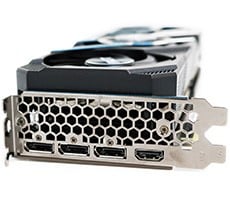Z77 Mobo Roundup II: EVGA, ASRock, Gigabyte, Zotac
ASRock Fatal1ty Z77 Professional: Although this is a fancy pro gamer-branded board, the price tag doesn’t seem to be inflated by it; considering what you get, $229.99 isn’t a bad deal at all, especially given the somewhat compelling extra Fatal1ty-branded features. The Z77 Pro can handle big-time graphics with quad-SLI/CrossFireX support, and we like the dual-LAN with teaming capability as well. It’s a little light on ports, with just six SATA ports and six USB ports (eight USB if you count the front header), although they’re all next-generation SATA 6Gbps and USB 3.0, respectively. The board's also got an excellent UEFI and it was a decent overclocker. If you're looking to build an Intel-based system for gaming, the ASRock Fatal1ty Z77 Pro is a great option.

ASRock Fatal1ty Z77 Professional
EVGA Z77 FTW: At a steep $329.99, the EVGA Z77 FTW is by far the priciest board in the roundup, and it’s hard to justify the cost--unless your a hardcore overclocked, that is. The thing is definitely built for graphics superiority with support for four-way SLI/CrossFireX, and there’s clearly an impressive amount of overclocking headroom to spare. The EVGA Z77 FTW was the best overclocking board of the bunch and allowed us to take our particular CPU to its highest frequency yet. Although it doesn’t have as many next-gen SATA and USB ports as the ASRock board, it’s got way more than enough in total: sixteen USB and fourteen SATA, with dual LAN ports.
Gigabyte Z77X-UD3H: The Gigabyte Z77X-UD3H is a more budget-friendly option than the Z77X-UD5H, and it’s the steal of the group at just $159.99. Though all the boards posted similar scores in our tests, the Gigabyte board was usually a hair better than the rest. True, it doesn’t have quite the expandability options of some other boards, but it can still run a pair of graphics cards and has a strong array of onboard display output options. Further, it has an mSATA port, so users can give a system built on this board a bump in performance using Intel's SRT for very little extra dough.
Zotac Z77-ITX WiFi: Zotac continues to amaze with what it can cram into a mini-ITX motherboard; for its size, there’s a reasonable number of ports onboard, including two HDMI ports and a mini-DisplayPort, and the mSATA port makes for a nice performance-boosting option. It’s also impressive that the Z77-ITX WiFi has dual LAN ports in addition to the WiFi + Bluetooth module. The limited expansion capabilities ensure that this little board is relegated to only certain use cases, and considering that, $199.95 might be a tad pricey despite its many excellent features and solid performance.

EVGA Z77 FTW
Gigabyte Z77X-UD3H
Zotac Z77-ITX WiFi






